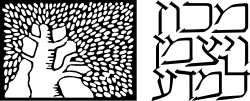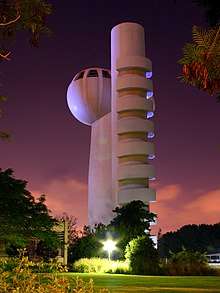Weizmann Institute of Science
|
מכון ויצמן למדע | |
 | |
Former name | Daniel Sieff Research Institute (1934–1949) |
|---|---|
| Type | Public research |
| Established | 1934 |
| Founder | Chaim Weizmann |
| President | Prof. Daniel Zajfman |
Academic staff | 952 |
Administrative staff | 400 |
| Students | 1,082 |
| Postgraduates | 356 |
| 700 | |
| Location | Rehovot, Israel |
| Campus | Urban |
| Postdoctoral fellows | 380 |
| Website | www.weizmann.ac.il |
|
| |

The Weizmann Institute of Science (Hebrew: מכון ויצמן למדע Machon Weizmann LeMada) is a public research university in Rehovot, Israel, established in 1934, 14 years before the State of Israel. It differs from other Israeli universities in that it offers only graduate and postgraduate degrees in the natural and exact sciences.
It is a multidisciplinary research center, with around 3,800 scientists, postdoctoral fellows, Ph.D. and M.Sc. students, and scientific, technical, and administrative staff working at the Institute.[1][2]
As of 2018, 6 Nobel laureates and 3 Turing Award winners have been associated with the Weizmann Institute of Science.
History
_-_President_Chaim_Weizmann.jpg)
Founded in 1934 by Chaim Weizmann and his first team, among them Benjamin M. Bloch, as the Daniel Sieff Research Institute. Weizmann had offered the post of director to Nobel Prize laureate Fritz Haber, but took over the directorship himself after Haber's death en route to Palestine. Before he became President of the State of Israel in February 1949, Weizmann pursued his research in organic chemistry at its laboratories. The institute was renamed the Weizmann Institute of Science in his honor on November 2, 1949, in agreement with the Sieff family.
WEIZAC, one of the world’s first electronic computers was locally built by the institute in 1954–1955 and was recognized by the IEEE in 2006 as a milestone achievement in the history of electrical and electronic engineering.[3]
In 1959, the institute set up a wholly owned subsidiary called Yeda Research and Development Company to commercialize inventions made at the institute.[4] By 2013 the institute was earning between $50 and $100 million in royalties annually on marketed drugs including Copaxone, Rebif, and Erbitux.[5][6]
Details
The Weizmann Institute presently has about 2,500 students, postdoctoral fellows, staff, and faculty, and awards M.Sc. and Ph.D. degrees in mathematics, computer science, physics, chemistry, biochemistry, and biology, as well as several interdisciplinary programs.[1] The symbol of the Weizmann Institute of Science is the multibranched Ficus tree.[7]
Undergraduates and recent graduates must apply to M.Sc. programs, while those earning an M.Sc. or an MD can apply directly to Ph.D. programs. Full fellowships are given to all students.
Youth programs

In addition to its academic programs, the Weizmann Institute runs programs for youth, including science clubs, camps, and competitions. The Bessie F. Lawrence International Summer Science Institute accepts high-school graduates from all over the world for a four-week, science-based summer camp. The Clore Garden of Science, which opened in 1999, is the world’s first completely interactive outdoor science museum.[1][8]
Rankings
In 2017, the Weizmann Institute made the Academic Ranking of World Universities at an unspecified place between 101 and 150 and the U.S. News' Best Global Universities list in 104th place.[9][10] In the 2017 CWTS Leiden Ranking, based on the proportion of a university's scientific papers published between 2012 and 2015 that made the 10% most cited in their field, it was ranked 13th in the world and first in Israel.[11]
Presidents
- Chaim Weizmann (1934–1952)
- Meyer Weisgal (1952–1959 as acting director)
- Abba Eban (1959–1966)
- Meyer Weisgal (1966–1970)
- Albert Sabin (1970–1972)
- Israel Dostrovsky (1972–1975)
- Michael Sela (1975–1985)
- Aryeh Dvoretzky (1985–1988)
- Haim Harari (1988–2001)
- Ilan Chet (2001–2006)
- Daniel Zajfman (2006–present)
The nonscientists Abba Eban and Meyer Weisgal were assisted by scientific directors, as was Weizmann himself owing to his duties as the first president of Israel. The following persons held the position of scientific director:
- Ernst David Bergmann (1949–1951)
- Amos de-Shalit (1960–1961 and 1966–1968)
- Shneior Lifson (1962–1966)
- Gerhard M. J. Schmidt (1969)
Faculty
- Uri Alon, systems biologist
- Ruth Arnon, immunologist
- Arkady Aronov, condensed matter physicist
- Mordechai Ben-Ari, computer scientist
- Ari Ben-Menahem, geophysicist
- Achi Brandt, mathematician
- Irun Cohen, immunologist
- David Danon, biologist
- Amos de-Shalit, physicist
- Irit Dinur, computer scientist and mathematician
- Israel Dostrovsky, physical chemist
- Yadin Dudai, neuroscientist
- Harry Dym, mathematician
- Marvin Edelman, biologist
- Benjamin Elazari Volcani discovered life in the Dead Sea and pioneered biological silicon research.
- Aviezri Fraenkel, mathematician
- Asher A. Friesem, physicist
- Stephen Gelbart, mathematician
- Joseph Gillis, mathematician
- Oded Goldreich, computer scientist
- Shafrira Goldwasser, computer scientist two-time winner of the Godel Prize (1993 and 2001), and the Turing Award (2012)
- Jacob H. Hanna, stem cell biologist
- Haim Harari, theoretical physicist
- David Harel (born 1950), computer scientist
- Yoseph Imry, theoretical physicist
- Aharon Katzir, chemist
- Ephraim Katzir, biophysicist, fourth President of the State of Israel
- Bruria Kaufman, theoretical physicist
- Jacob Klein, chemist
- Erez Lapid, mathematician
- Ulf Leonhardt, physicist
- Alexander Lerner, mathematician
- Michael Levitt, chemical physics, presently at Stanford University: Nobel Prize in Chemistry (2013)
- Moshe Levy, chemist
- Shneior Lifson, physicist
- Harry J. Lipkin, physicist
- Henry Markram (born 1962), neuroscientist
- Meir Lahav, chemist[12]
- Mordehai Milgrom, astrophysicist
- David Milstein, organic chemist
- Moni Naor, computer scientist
- Chaim L. Pekeris, geophysicist
- Amir Pnueli, computer scientist, Turing Award (1996)
- Ran Raz, computer scientist
- Amitai Regev, mathematician
- Omer Reingold, computer scientist
- Leo Sachs, molecular biologist
- Josip Schlessinger, biochemist and biophysician
- David Samuel, 3rd Viscount Samuel, chemist
- Eran Segal, computational biologist
- Lee Segel, applied mathematician
- Michael Sela, immunologist
- Adi Shamir, cryptographer, Turing Award (2002)
- Ehud Shapiro, computer scientist and computational biologist
- Nathan Sharon, biochemist
- Amnon Shashua, computer scientist
- Franz Sondheimer, chemist
- Ady Stern, physicist
- Joel Sussman, crystallographer
- Igal Talmi, physicist
- Reshef Tenne, chemist
- Edward Trifonov, molecular biophysicist
- Shimon Ullman, computer scientist
- Gabriele Veneziano, theoretical physicist
- David Wallach, biochemist
- Arieh Warshel, chemical physics, presently at University of Southern California: Nobel Prize in Chemistry (2013)
- Chaim Weizmann, chemist, first President of the State of Israel
- Meir Wilchek, biochemist
- Ada Yonath, crystallographer, Nobel Prize in Chemistry (2009)
- Daniel Zajfman, physicist
Alumni
- Amikam Aharoni (1929–2002), physicist
- Dorit Aharonov (born 1970), computer scientist
- Joanna Aizenberg, professor of chemistry
- Uri Alon, systems biologist
- Ella Amitay Sadovsky (born 1964), artist
- Haim Aviv, molecular biologist
- Karen Avraham, geneticist
- Neta Bahcall, astrophysicist
- Eli Biham, cryptographer and cryptanalyst
- Ofer Biham, physicist
- Achi Brandt (born 1938), mathematician
- Joseph Buxbaum, geneticist and neuroscientist
- Nachum Dershowitz, computer scientist
- Danny Dolev, computer scientist
- Dov Dori, computer scientist
- Yadin Dudai, neuroscientist
- Amos Fiat, computer scientist
- Nir Friedman, computer scientist and biologist
- Ehud Gazit, biochemist and nanotechnologist
- Alexander Goldfarb, (born 1947), microbiologist, activist, and author
- Valerie Halyo, experimental physicist
- Eliezer (Eli) Huberman, biologist
- Yoseph Imry, theoretical physicist
- Jonathan Kipnis, neuroscientist
- Bernard H. Lavenda, chemical physicist
- Anders Levermann, climate scientist
- Alexander Levitzki (born 1940), biochemist
- Yehuda Lindell, computer scientist
- Mario Livio (born 1945), astrophysicist
- Miron Livny, computer scientist
- Henry Markram (born 1962), neuroscientist
- Raphael Mechoulam, organic chemist
- David Peleg, computer scientist
- Amir Pnueli (1941–2009), computer scientist
- Omer Reingold, computer scientist
- Gideon Rodan, biochemist
- Barton Rubenstein, modernist sculptor
- Shmuel Safra, computer scientist
- Josip Schlessinger (born 1945), biochemist and biophysician
- Nathan Seiberg, physicist
- Adi Shamir (born 1952), cryptographer
- Amnon Shashua, computer scientist
- Andrey Sivachenko, computational biologist and computer scientist. Professor at Harvard University Extension School
- Nahum Sonenberg, biochemist
- Hermona Soreq, molecular neuroscientist
- Eli Upfal, computer scientist
- Lev Vaidman, physicist
- Moshe Vardi, computer scientist
- Inder Verma, cancer researcher and molecular biologist
- Ada Yonath, crystallographer
- Arieh Warshel, chemist
- Meir Wilchek, biochemist
- Doron Zeilberger, mathematician
- Eitan Zemel, applied mathematician
Access
Train
- From downtown Tel-Aviv, take a train from either the University, Savidor Center, HaShalom, or HaHagana stations headed to the Rehovot Railway Station or to the Ashkelon Railway Station via Lod. Disembark at Rehovot station which is located nearby the campus. Travel time will be about 25 minutes from Tel Aviv HaHagana. To the main gate, it will be an additional 5-minute walk.
- From Ben Gurion Airport, take any Tel Aviv bound train from Ben Gurion Airport Railway Station, located at the lower level of Terminal 3 to Tel Aviv HaHagana Railway Station. Change to a train bound for Rehovot or Ashkelon via Lod and follow the instruction above. Total travel time will be about 50 minutes, depending on train connection/transfer.
See also
References
- 1 2 3 "Scientific Activities: The Yeda-Sela (YeS) Center for Basic Research". Retrieved 25 July 2015.
- ↑ "Facts and Figures - Weizmann Institute of Science". Retrieved 25 July 2015.
- ↑ "Milestones: WEIZAC Computer, 1955". IEEE. Retrieved 7 March 2018.
- ↑ Borchardt, John (September 26, 2000). "Israeli biotech - a child with great promise". The Scientist.
- ↑ OECD Reviews of Innovation Policy OECD Reviews of Innovation Policy. OECD Publishing. 2006. p. 119. ISBN 9789264029750.
- ↑ Weinreb, Gali (28 July 2013). "Yeda earns $50-100m annually". Globes (in Hebrew).
- ↑ Institution resource development, Weizmann Institute of Science
- ↑ "2BackToHomePage3". Retrieved 25 July 2015.
- ↑ "Best Global Universities". Retrieved 23 Jan 2018.
- ↑ "Academic Ranking of World Universities". Center for World-Class Universities of Shanghai Jiao Tong University. Retrieved 27 July 2015.
- ↑ "CWTS Leiden Ranking". Leiden University. Retrieved 23 Jan 2018.
- ↑ https://www.weizmann.ac.il/materials/LahavPage.html
External links
| Wikimedia Commons has media related to Weizmann Institute of Science. |
- Weizmann Institute of Science Website (in English)
Coordinates: 31°54′27″N 34°48′33″E / 31.90750°N 34.80917°E